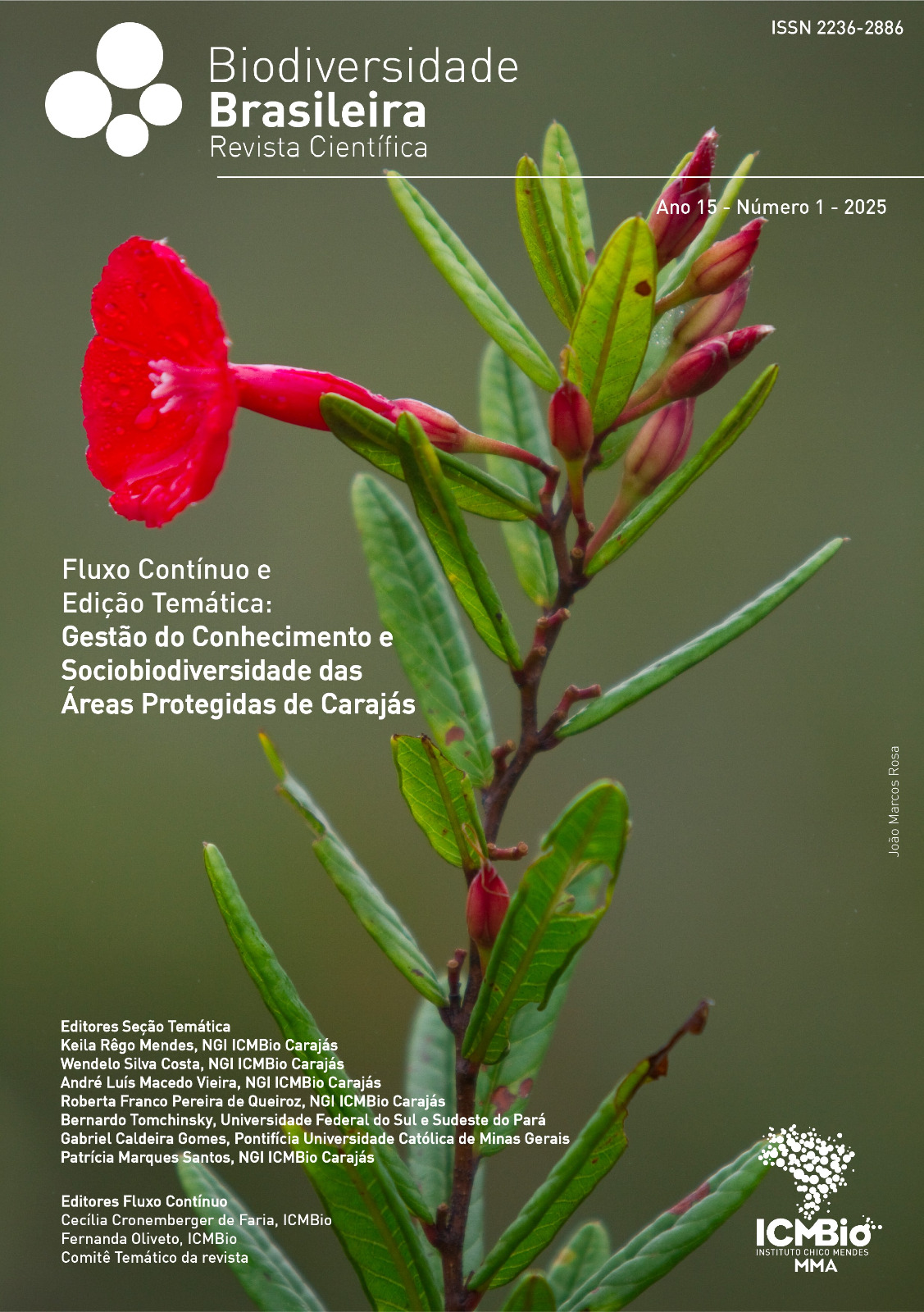Alternative methods for weed competition control in an agroforestry system with cacao in the Amazon biome
DOI:
https://doi.org/10.37002/biodiversidadebrasileira.v15i1.2677Keywords:
Planting crown , textile mulch , Theobroma cacao , weedsAbstract
Weed control is one of the main demands in the initial management of Theobroma cacao L. plants in the Amazon region. Thus, the objective of this study was to evaluate the effect of different physical methods in the crowning of clonal cacao seedlings in an agroforestry system as a strategy for weed control. The experiment was conducted in an area belonging to the Rancho Pioneiros Company, in the municipality of Parauapebas, Pará, using a randomized block design, with a spacing of 3 m x 3 m. The treatments applied to the crown of the seedlings were: Control (T1); conventional weeding (T2); textile mat (T3); straw (T4); wood shavings (T5); cardboard (T6); double-sided tarp (T7); and planting crown (T8). The textile mat (T3) was made of jute enriched with fertilizer and pre-emergent herbicide. At 90 days after planting, the survival, height, stem diameter, and Falker chlorophyll index a (ICFa) and b (ICFb) of the seedlings were evaluated, as well as the weed biomass in the crown. Seedling survival and initial growth were not influenced by the treatments. However, the use of straw and manual crowning resulted in higher ICFa and ICFb values, indicating better physiological conditions, which can promote greater plant growth. The alternative methods tested showed great potential for weed suppression, being an efficient strategy for weed control and favorable for the physiological conditioning of the initial establishment of cacao tree in agroforestry systems.
Downloads
References
1. De Almeida AA, Valle RR. Ecophysiology of the cacao tree. Brazilian J Plant Physiol. 2007;19(4):425–48. doi: 10.1590/S1677-04202007000400011 DOI: https://doi.org/10.1590/S1677-04202007000400011
2. IBGE - Instituto Brasileiro De Geografia E Estatística. Dados da safra (2022) [Intern. 2023. Disponível em: https://sidra.ibge.gov.br/tabela/1618#resultado
3. SENAR. Cacau : manejo e colheita. SENAR - Serviço Nacional de Aprendizagem, editor. Brasília; 2018. 145 p. Disponível em: https://www.cnabrasil.org.br/assets/arquivos/215-CACAU.pdf
4. Gama-Rodrigues AC, Müller MW, Gama-Rodrigues EF, Mendes FAT. Cacao-based agroforestry systems in the Atlantic Forest and Amazon Biomes: An ecoregional analysis of land use. Agric Syst. 2021 Dec;194(April):103270. doi: 10.1016/j.agsy.2021.103270 DOI: https://doi.org/10.1016/j.agsy.2021.103270
5. Konlan S, Quaye AK, Pobee P. Amon-Armah F, Dogbatse JA, Arthur A, Fiakpornu R, Dogbatzi R. Effect of weed management with glyphosate on growth and early yield of young cocoa (Theobroma cacao L.) in Ghana. African J Agric Res. 2019 Jul 11;14(28):1229–38. doi: 10.5897/AJAR2018.13555 DOI: https://doi.org/10.5897/AJAR2018.13555
6. Neto PJ da S, Neto OG da R, Santana AC de. Custos com o controle de plantas invasoras no cultivo do cacaueiro em sistemas agroflorestais. Rev Ciências Agrárias. 2009;51(1):69–82.
7. Faria JCT, Gonçalves EO, Delarmelina WM, Assumpção CRM de, Caldeira MVW. Influência da matocompetição de capim-braquiária no crescimento inicial de espécies florestais em plantio misto. Rev Ciências Agroambientais. 2018;16(1):62–71. doi: 10.5327/rcaa.v16i1.1449 DOI: https://doi.org/10.5327/Z1677-606220181449
8. De Barros AF, Pimentel LD, Araujo EF, De Macedo LR, Martinez HEP, Batista VAP, et al. Super absorbent polymer application in seeds and planting furrow: It will be a new opportunity for rainfed agriculture. Semin Agrar. 2017;38(4):1703–14. doi: 10.5433/1679-0359.2017v38n4p1703 DOI: https://doi.org/10.5433/1679-0359.2017v38n4p1703
9. Saha D, Cregg BM, Sidhu MK. A review of non-chemical weed control practices in christmas tree production. Forests . 2020 May 14;11(5):554. doi: 10.3390/f13020250 DOI: https://doi.org/10.3390/f11050554
10. Aneani F, Ofori-Frimpong K. An analysis of yield gap and some factors of cocoa (Theobroma cacao) yields in Ghana. Sustain Agric Res. 2013 Sep 22;2(4):117. doi: 10.5539/sar.v2n4p117 DOI: https://doi.org/10.5539/sar.v2n4p117
11. Santos DS dos. Influência de diferentes materiais para controle de plantas competidoras no crescimento inicial de Araucaria angustifolia. Universidade Tecnológica Federal do Paraná; 2018.
12. Zavistanovicz TC, Aimi SC, Araujo MM, Berghetti ÁLP, Gomes DR, Barbosa FM. Production techniques of arboreal species seedlings and use of mulching in an altered area. Rev Árvore. 2021;45:1–11. doi: 10.1590/1806-908820210000020 DOI: https://doi.org/10.1590/1806-908820210000020
13. Procópio S de O, Cintra FLD, Resende RS. Seminário sobre manejo sustentável para a cultura do coqueiro. Coberturas de solo para o manejo de plantas daninhas em áreas de produção de coco. In: Cintra FLD, Fontes HR, editors. Seminário sobre Manejo Sustentável para a Cultura do Coqueiro. 2017. p. 37–58.
14. Alvares CA, Stape JL, Sentelhas PC, de Moraes Gonçalves JL, Sparovek G. Köppen’s climate classification map for Brazil. Meteorol Zeitschrift. 2013 Dec 1;22(6):711–28. doi: 10.1127/0941-2948/2013/0507 DOI: https://doi.org/10.1127/0941-2948/2013/0507
15. Santos HG dos, Jacomine PKT, Anjos LHC dos, Oliveira, V. A. de Lumbreras, J. F. Coelho MR, Almeida, J. A. de Araujo Filho, J. C. de Oliveira, J. B. de Cunha TJF. Sistema brasileiro de classificação de solos. 5th ed. Brasília: Embrapa; 2018. 456 p.
16. Ferreira E, Cavalcanti P, Nogueira D. ExpDes.pt: Experimental Designs pacakge (Portuguese). R package version 1.1.2.; 2021.
17. R Core Team. R: A Language and Environment for Statistical Computing. Vienna, Austria: R Foundation for Statistical Computing; 2018.
18. Berghetti ÁLP, Araujo MM, Tabaldi LA, Turchetto F, Aimi SC, Rorato DG, et al. Morphological, physiological and biochemical traits of Cordia trichotoma under phosphorous application and a water-retaining polymer. J For Res. 2020 Apr 29. doi: 10.1007/s11676-020-01132-8 DOI: https://doi.org/10.1007/s11676-020-01132-8
19. Dogbatse JA, Arthur A, Awudzi GK, Quaye AK, Konlan S, Amaning AA. Effects of organic and inorganic fertilizers on growth and nutrient uptake by young cacao (Theobroma cacao L.). Serrano M, editor. Int J Agron. 2021 Mar 19;2021:1–10. doi: 10.1155/2021/5516928 DOI: https://doi.org/10.1155/2021/5516928
20. Martins SV, Braz J de P, Villa PM, Alves WVL, Valente ML, Kruschewsky GC, et al. Avaliação de nucleários como técnica de restauração florestal em Mariana, MG, Brasil. Pesqui Florest Bras. 2022 Dec 31;42:1–14. doi: 10.4336/2022.pfb.42e202002154 DOI: https://doi.org/10.4336/2022.pfb.42e202002154
21. Serra WS, Sodré GA. Manual Do Cacauicultor: perguntas e respostas [Internet]. Boletim Té. Ilhéus, BA: CEPLAC/CEPEC; 2021. 190 p.
22. Da Silva Branco MC, de Almeida A-AF, Dalmolin ÂC, Ahnert D, Baligar VC. Influence of low light intensity and soil flooding on cacao physiology. Sci Hortic. 2017 Mar;217:243–57. doi: http:10.1016/j.scienta.2017.01.038 DOI: https://doi.org/10.1016/j.scienta.2017.01.038
23. De Almeida J, Tezara W, Herrera A. Physiological responses to drought and experimental water deficit and waterlogging of four clones of cacao (Theobroma cacao L.) selected for cultivation in Venezuela. Agric Water Manag. 2016 Jun;171:80–8. doi:10.1016/j.agwat.2016.03.012 DOI: https://doi.org/10.1016/j.agwat.2016.03.012
24. Sauter M. Root responses to flooding. Curr Opin Plant Biol. 2013 Jun;16(3):282–6. doi: 10.1016/j.pbi.2013.03.013 DOI: https://doi.org/10.1016/j.pbi.2013.03.013
25. Araujo MM, Navroski MC, Schorn LA, Tabaldi LA, Rorato DG, Turchetto F, et al. Caracterização e análise de atributos morfológicos e fisiológicos indicadores da qualidade de mudas em viveiro florestal. In: Araujo MM, Navroski MC, Schorn LA, editors. Produção de sementes e mudas um enfoque à Silvicultura. 1st ed. Santa Maria: UFSM; 2018. p. 345–65.
26. Taiz L, Zeiger E, Moller I, Murphy A. Fisiologia e desenvolvimento vegetal. 6th ed. Porto Alegre: Artmed; 2017. 888 p.
27. Bastos ACV, Razera, R, Franco FS. Coroamento com papelão para o controle de Brachiaria decumbens em sistemas agroflorestais. Cadernos de Agroecologia – ISSN 2236-7934 - Anais do XI Congresso Brasileiro de Agroecologia, São Cristóvão, Sergipe - v. 15, no 2, 2020.
28. Martins EG, Neves, EJM, Santos AF, Ferreira, CA. Métodos alternativos para o controle de plantas daninhas em plantios de pupunheira como componente de sistema agroflorestal. Anais do V Congresso Brasileiro de Sistemas Agroflorestais, p. 286 – 288, 2004.
Downloads
Published
Issue
Section
License
Copyright (c) 2025 Os autores mantêm os direitos autorais de seus artigos sem restrições, concedendo ao editor direitos de publicação não exclusivos.

This work is licensed under a Creative Commons Attribution-NonCommercial-NoDerivatives 4.0 International License.
Os artigos estão licenciados sob uma licença Creative Commons Atribuição-NãoComercial-SemDerivações 4.0 Internacional (CC BY-NC-ND 4.0). O acesso é livre e gratuito para download e leitura, ou seja, é permitido copiar e redistribuir o material em qualquer mídia ou formato.












